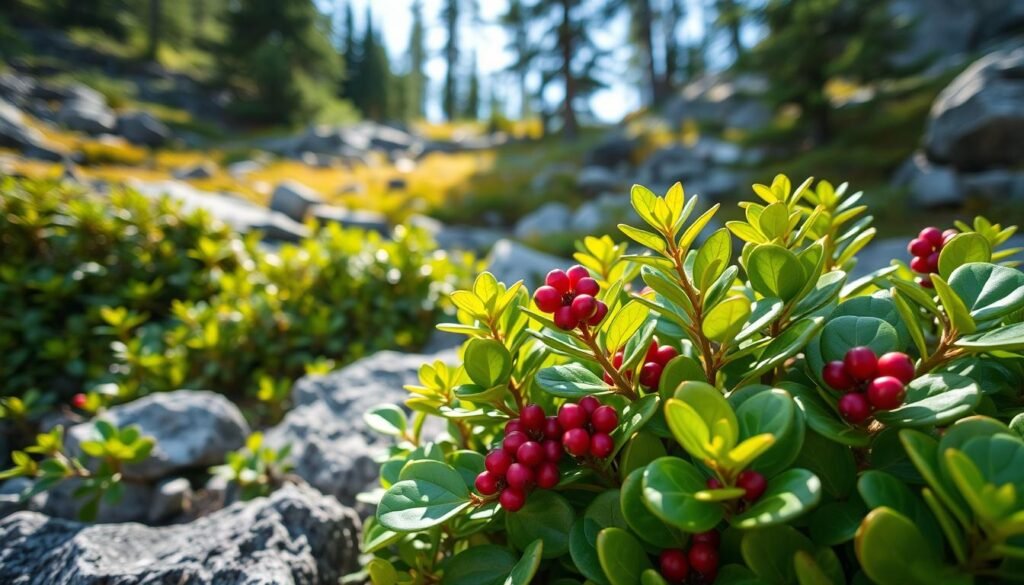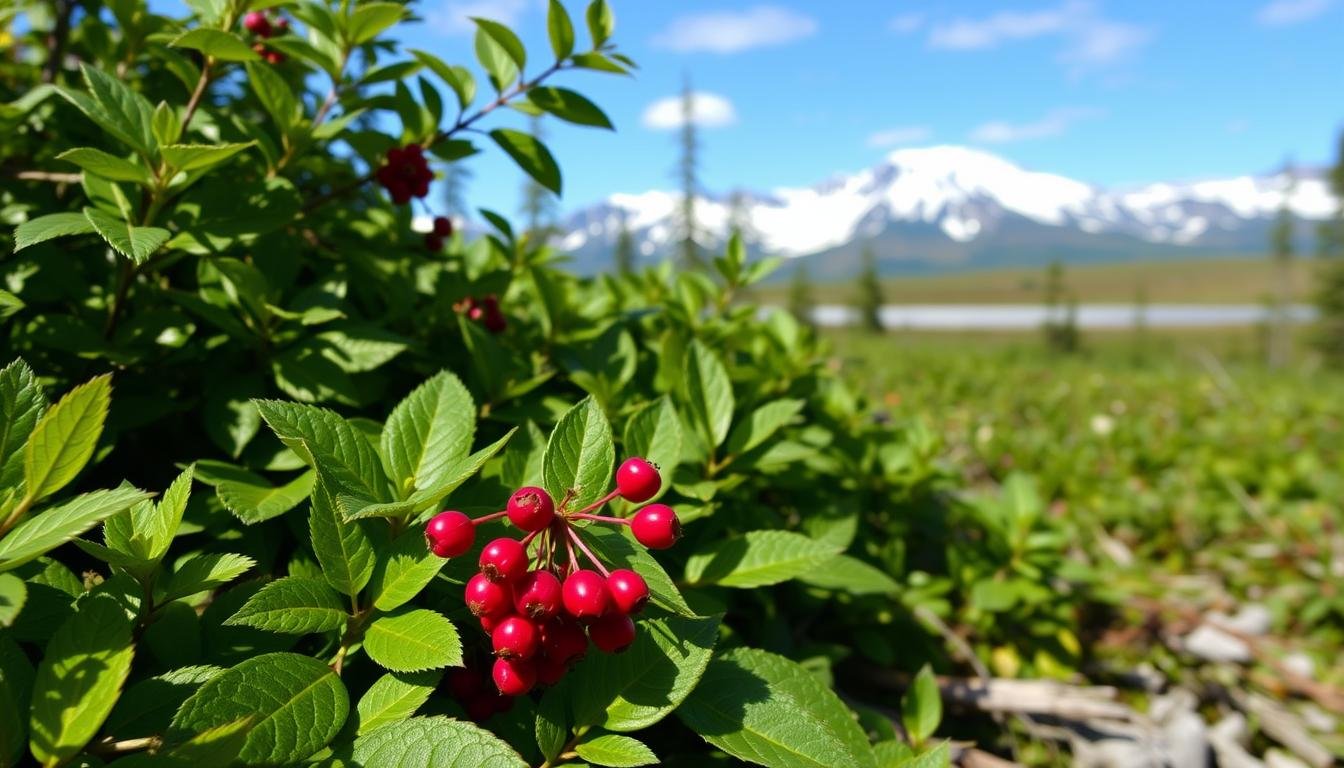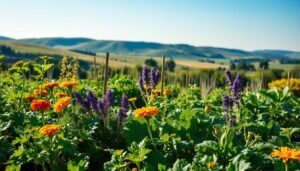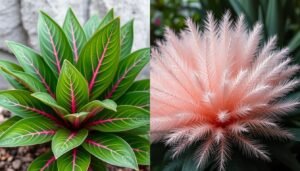As I explore Alaska’s wilderness, I find Gaultheria procumbens, or wintergreen, interesting. It grows in Alaska’s cold areas. The question is, can Gaultheria procumbens in Alaska be eaten? This plant is known for its minty taste and has been used in traditional ways.
But, it’s important to know if it’s safe to eat. This is especially true when looking for Alaska edible plants.
In this article, we’ll look at wintergreen’s traits, how it grows, and its history. We’ll also talk about its safety and health benefits. It’s important to understand gaultheria procumbens edibility beyond its taste. We’ll also discuss its role in nature and how to forage responsibly.
Key Takeaways
- Gaultheria procumbens is common in USDA Hardiness Zones 4-9 in Alaska.
- The plant typically grows 2 to 12 inches tall and retains its leaves throughout the year.
- It is rated 1 out of 5 for edibility, indicating limited recommendations for consumption.
- The berries offer a sweet and minty taste, suitable for jams or desserts.
- Caution is advised when consuming wintergreen due to potentially harmful compounds in large quantities.
Table of Contents
What is Gaultheria Procumbens
Gaultheria procumbens, also known as wintergreen, is a special plant in Alaska. It grows low to the ground, reaching 4 to 6 inches tall. It loves the cool, moist air of Alaska’s forests.
Its leaves are dark green, oval, and shiny. They are 1 to 2 inches long. When you crush them, they smell like mint.
The plant makes bright red berries in late summer. These berries stay on the plant all winter. They add color and might be good to eat or use for medicine.
In early summer, wintergreen plants bloom. They have small, white or pale pink flowers. These flowers make the plant look nice.
Wildlife loves Gaultheria procumbens. The berries are food for animals. The leaves and stems give them a place to hide.
Indigenous people in Alaska have used wintergreen for medicine for a long time. They find it helpful for their health.
Wintergreen leaves and berries are full of antioxidants. Antioxidants fight off bad stuff in our bodies. But, be careful with the leaves. They have something called methyl salicylate that can be harmful if you eat too much.
In short, Gaultheria procumbens is more than just a plant. It’s a key part of Alaska’s nature and helps people too.
What Are Wintergreen Plants?
Wintergreen plants, like Gaultheria procumbens, are truly special. They have shiny leaves and bright red berries. These plants grow in damp places and rocky spots.
Characteristics of Gaultheria Procumbens
Gaultheria procumbens is quite interesting. It’s a small, woody plant that grows low to the ground. It has:
- Dark green leaves that look lush and attractive.
- White flowers in summer, followed by red berries.
- It’s found in many places in the U.S. and Canada.
This plant likes shady spots but also does well in sunny areas. It’s good for the soil and helps animals like chipmunks and deer.
Importance in Ecosystems
Wintergreen plants are very important. Gaultheria procumbens helps keep nature balanced by:
- Feeding birds and small animals in winter.
- Helping the soil and keeping forests healthy.
- Attracting bees and butterflies to help other plants.
This plant makes its area better and helps the whole nature community.
| Feature | Description |
|---|---|
| Height | 4 to 6 inches tall |
| Leaf Type | Simple, dark green |
| Flowering Period | June to September |
| Fruit Color | Bright red |
| Wildlife Interactions | Food source for various birds and mammals |
Growing Conditions in Alaska
Understanding what wintergreen Alaska needs to grow is key. Gaultheria procumbens loves certain conditions to thrive. These conditions help it grow well in the wild.
Preferred Soil Types and pH Levels
The soil for Gaultheria procumbens should be rich and acidic. It should have a pH less than 6.0. Wintergreen grows best in cool, moist places.
Shaded woodlands are perfect for them. This helps them grow well without too much sun. Knowing the right soil is crucial for growing and foraging.
USDA Hardiness Zones and Climate Adaptability
Gaultheria procumbens grows well in zones 3 to 7. In Alaska, it likes shaded areas. This keeps it cool, which it prefers.
It can handle deer and rabbit grazing. It also does well in shade. These plants grow 4 to 8 inches tall. They make great ground cover and help local plants.
Keeping the right growing conditions helps wintergreen plants stay healthy. It also helps the whole ecosystem. For more tips on plant care, check out this resource on birds of paradise plants.
Are Wintergreen Plants in Alaska Edible?

Wintergreen plants, like Gaultheria procumbens, or the American wintergreen, are safe to eat. But, it’s important to be careful when using them in cooking. The leaves and berries taste strong and might be good for you, but eat them in small amounts.
General Edibility Considerations
The leaves and berries of wintergreen plants taste like sweet mint. Foraging for them is fun and can teach you about Alaska’s native foods. The red berries are small and full of flavor and nutrients. But, eating too much can be bad because of a chemical similar to aspirin.
Historical Use by Indigenous Peoples
Indigenous peoples in North America used wintergreen for food and medicine. The Delaware and Mohicans used the leaves for taste and health. They made poultices from the leaves to help with pain and arthritis. This shows how important wintergreen was to their culture.
Today, people are interested in foraging again. It lets them connect with nature and learn about plants like wintergreen. For more info, check out winter foraging resources.
| Aspect | Description |
|---|---|
| Flavor Profile | Mildly sweet, minty taste |
| Plant Parts Edible | Leaves and berries |
| Consumption Advice | Moderation is recommended |
| Medicinal Uses | Topical application for pain relief |
Edibility of Wintergreen Berries
Wintergreen berries are really interesting. They are small, blue-black, and taste sweet and minty. Many foragers love them. In Alaska, I often ask, “Are wintergreen berries edible?” Yes, they are. You can eat them raw or use them in jams, desserts, and sauces.
The berries of Alaska are full of flavor and health benefits. Native Americans used them a lot. They even used them to sweeten dishes and thicken salmon eggs. This shows how important wintergreen berries were to them.
Using local ingredients like these berries makes Alaskan food special. For those exploring the wild, these berries add color and taste to dishes. When I pick them, I think about their history and the beauty of nature.
| Berry Type | Characteristics | Culinary Uses |
|---|---|---|
| Wintergreen Berries | Blue-black, sweet, minty flavor | Raw eating, jams, desserts, sauces |
| Salal Berries | Dark blue, unique flavor | Fresh, cakes, dried |
| Huckleberries | Purple, similar to Gaultheria shallon | Fresh eating, jams |
Enjoying wintergreen berries is not just tasty. It also connects me to Alaska’s natural heritage. Exploring wild fruits like these opens up a world of flavors and culture.
Edibility of Wintergreen Leaves
Wintergreen leaves (Gaultheria procumbens) are safe to eat but should be used with care. They contain compounds like methyl salicylate. People have used them in cooking and medicine for a long time.
Traditional Uses and Preparations
For years, people have made tea from wintergreen leaves. It’s a way to enjoy their taste and feel calm. The Alaskan Native people have used them for generations. They like the leaves for their flavor and calming effect.
Here are some ways to use wintergreen leaves:
- Brewing leaves for herbal tea, offering a refreshing minty flavor
- Finely chopping leaves to incorporate into salads
- Using leaves in marinades or dressings for added flavor
Wintergreen leaves can make dishes special. But, it’s important to mix them with other foods. This way, you can be creative and connect with old traditions.
Health Benefits of Wintergreen Plants
Wintergreen plants, like Gaultheria procumbens, have many health benefits. They help with physical wellness and comfort. These plants have special compounds that support the body, making them valuable in nature’s pharmacy.
Pain Relief Properties
Wintergreen is known for its wintergreen pain relief properties. It has methyl salicylate, which works like aspirin. When I have headaches or muscle pain, I use wintergreen oil or tea. It really helps.
Wintergreen is a great natural way to manage pain.
Digestive and Respiratory Benefits
Wintergreen also helps with digestive health wintergreen. Drinking its tea can ease stomach issues like nausea. It also helps clear the airways, making it easier to breathe during colds.
Adding wintergreen to my wellness routine has been helpful, especially during colds.
| Health Benefit | Description | Key Component |
|---|---|---|
| Pain Relief | Aids in alleviating headaches and muscle pain | Methyl Salicylate |
| Digestive Health | Soothes digestive discomfort and nausea | Natural Extracts |
| Respiratory Health | Helps clear respiratory passages during colds | Essential Oils |
Can Gaultheria Procumbens in Alaska Be Eaten?
Yes, Gaultheria procumbens, also known as wintergreen, is safe to eat. The berries and leaves are okay to eat in small amounts. When I forage in Alaska, I love the taste of the berries and leaves.
But, we must be careful when eating them. Always pick from clean places. This keeps us healthy and the nature around us balanced.
Knowing how much to eat is important. Too much can cause problems. Eating mindfully makes the experience better.
Exploring Gaultheria procumbens shows me its deep history. It has been used by Indigenous peoples for a long time. Today, we can use it in many ways, like in teas and desserts.
Following foraging tips in Alaska helps us enjoy wintergreen more. It makes us appreciate this special plant even more.




